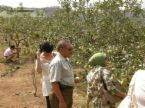This june is started with a lot of festival rose. I cant wait to round of this country just to see it. Some schedule for rose festival that i have from
: www.oregonlive.com and www.portlandobserver.com.

FRIDAY, MAY 30
Rose Cup Races: More than 400 drivers from the United States and Canada compete in various classes at Portland International Raceway, West Delta Park. Gates open 7 a.m. through Sunday, culminating with the Rose Cup race at 1:40 p.m. Sunday. Daily tickets and three-day passes on sale via Ticketmaster, 224-4400. Continues through June 1. Details: www.rosecup.com
 SATURDAY, MAY 31
SATURDAY, MAY 31
Key Bank Starlight Run: The largest fun run in Oregon, with more than 4,000 runners expected this year. Dress up and win prizes for best costume. Run (3.1 miles) starts at Lincoln High School, Southwest 16th Avenue and Salmon Street. Registration 6:30 p.m. Entry fee: $12-$29. Costume judging: 7:15 p.m. Race starts at 8 p.m. Details: www.starlightrun.com
Naval Fleet: Vessels from the U.S. Navy, U.S. Coast Guard and the Canadian Maritime Forces arrive from around the world. Ships moor along Tom McCall Waterfront Park's harbor wall from the Steel Bridge to Waterfront Village. Tours available daily; 9:30 a.m.-4:30 p.m.; free. Continues through June 8. Details: www.rosefestival.org/events/fleet

SUNDAY, JUNE 1
26th Annual Rose Art Show: 2008 Rose Festival Art Competition. Artist reception: 1-4 p.m. Sun. Oregon Society of Artists, 2185 S.W. Park Place. Continues through June 27. Details: 228-0706; www.oregonsocietyofartists.com
THURSDAY, JUNE 5
Lloyd Center/Portland Rose Society Spring Rose Show: The 120th annual event is the country's oldest and largest rose show. 1-9 p.m., continues Friday 10 a.m.-5 p.m.; Lloyd Center Ice Rink. Tickets $3; available at Ticketmaster. Details: www.portlandrosesociety.org
FRIDAY, JUNE 6 Concert at the Park: A variety of musical acts for the entire family. Headlining the show will be the Rose Festival One More Time Around Again Marching Band. 7 p.m. at PGE Park, reserved seating; $12-$15. Ticketmaster; 224-4400.
Royal Rosarian Knighting Ceremony: 10 a.m., Rose Garden Amphitheatre, Washington Park. Details: www.royalrosarians.org
2008 Festival of Flowers: Presented by Hoffman Construction Co., this year's design, Urban Meadow, will be on display at Pioneer Courthouse Square. Flower display: 6 a.m.-midnight June 6-18. Flower sale: 8 a.m.-6 p.m. Thursday-Friday, 9 a.m.-6 p.m. Saturday-Sunday, June 19-22. Continues through June 22. Details: 223-1613; www.pioneercourthousesquare.org
Mock's Crest Productions presents Gilbert & Sullivan's classic, "Pirates of Penzance": 7:30 p.m. Thursday-Saturday, 2 p.m. Sunday. Mago Hunt Theater, University of Portland, 5000 N. Willamette Blvd. Continues through June 29. Details: 943-7287
SATURDAY, JUNE 7
Queen's Coronation presented by Pacific Power: The Rose Festival queen will be announced Saturday morning in Memorial Coliseum just before the Rose Festival Grand Floral Parade. 8:30 a.m., Tickets $30; www.rosefestival.org
"From One Rose" Motion Picture: At the Historic Hollywood Theatre, the Portland Rose Festival will host a screening of its Centennial Motion Picture, "From One Rose." A cinematic journey through the life of a woman born at the turn of the century in Portland who grows up with the Rose Festival. 7 p.m. Tickets $10. Details: 281-4215; www.hollywoodtheatre.org
Regence Grand Floral Walk: The four-mile fitness walk's route is also the route of the Grand Floral Parade. The walk begins promptly at 9:30 a.m. at Memorial Coliseum. Registration fee: $10-$15; limited to 2,000 participants. Details: www.grandfloralwalk.com
Portland-Kaohsiung Sister City Association Dragon Boat Race: Nearly 100 teams will compete throughout the day in races held on the Willamette River in boats provided through the Portland-Kaohsiung Sister City Association. Races held at the south end of Tom McCall Waterfront Park along Southwest Naito Parkway. Continues through Sunday. Details: www.pksca.com
Bi-Mart X-Treme Air Dogs: Northwest Challenge Busch Beer Outdoor Series at Oaks Park in Sellwood. Hours: 9 a.m.-7 p.m., continues Sunday. Register before June 3; $20 fee. Details: 541-689-3612; www.northwestchallenge.com
Grand Floral Parade Float Viewing: Visit the float display on Southwest Naito Parkway adjacent to the Waterfront Village to view a closer look at this year's floats. 2-5 p.m., continues Sunday.













































